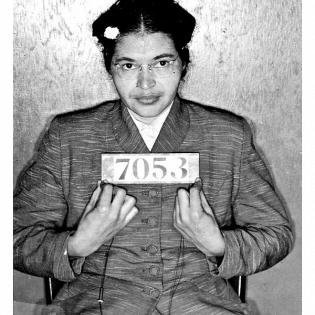Rosa Parks
Rosa Parks’s acts of philanthropy brought a community of people together for the common good and resulted in major social change in her community and in the nation. Young people identify the relationship between individual rights, justice, equality, and community responsibility.
The learner will:
- identify the relationship between individual rights and community responsibility.
- identify community as the degree that people come together for the common good.
an age-appropriate book about Rosa Parks, especially with a message that we all have the power to make a difference
Draw a bus with positive graffiti on it expressing words of fairness and justice in an ideal world.
- A good site for a summary of Rosa Parks’ life as well as links to other resource sites http://www.history.com/topics/black-history/rosa-parks
Instructions
Anticipatory Set:
Ask, "if a law or practice is not just or fair, whose responsibility is it to demand that it be changed?"
What if the practice is here at school? In the U.S. government? Across the world?
Introduce the young people to the story of Rosa Parks. Read aloud a biographical book. Discuss the setting and her actions. Define the word philanthropist as someone who gives their time and talent and uses their voice and connections for the good of all. Rosa Parks acted as a philanthropist when she demanded fair treatment for herself and others, and then she spoke up for what was right. Discuss how she was demanding rights and taking responsibility.
Locate the city of Montgomery, Alabama, on a map.
Discuss how philanthropic activities can bring about social change. Define social change.
Each of us has the power to use our voice and talents to take action to change what isn't fair.
Brainstorm social change needed to ensure justice and equality in your own community (the class, school, or local community).
Philanthropy Framework
-
Strand PHIL.I Definitions of Philanthropy
-
Standard DP 01. Define Philanthropy
-
Benchmark E.3 Recognize that citizens have a responsibility for the common good as defined by democratic principles.
-
-
Standard DP 02. Roles of Government, Business, and Philanthropy
-
Benchmark E.6 Explain why acting philanthropically is good for the community, state, nation, or world.
-
-
-
Strand PHIL.II Philanthropy and Civil Society
-
Standard PCS 02. Diverse Cultures
-
Benchmark E.5 Identify the relationship between individual rights and community responsibility.
-
-
Standard PCS 05. Philanthropy and Government
-
Benchmark E.1 Define community as the degree that people come together for the common good.
-
Benchmark E.9 Describe how philanthropic activities can bring about social change.
-
-
-
Strand PHIL.III Philanthropy and the Individual
-
Standard PI 01. Reasons for Individual Philanthropy
-
Benchmark E.2 Identify why people practice philanthropy related to their own self-interest.
-
-
